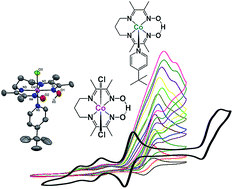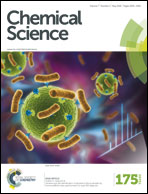Evaluation of the coordination preferences and catalytic pathways of heteroaxial cobalt oximes towards hydrogen generation†
Abstract
Three new heteroaxial cobalt oxime catalysts, namely [CoIII(prdioxH)(4tBupy)(Cl)]PF6 (1), [CoIII(prdioxH)(4Pyrpy)(Cl)]PF6 (2), and [CoIII(prdioxH)(4Bzpy)(Cl)]PF6 (3) have been studied. These species contain chloro and substituted tert-butyl/pyrrolidine/benzoyl-pyridino ligands axially coordinated to a trivalent cobalt ion bound to the N4-oxime macrocycle (2E,2′E,3E,3′E)-3,3′-(propane-1,3-diylbis(azanylylidene))bis(butan-2-one)dioxime, abbreviated (prdioxH)− in its monoprotonated form. Emphasis was given to the spectroscopic investigation of the coordination preferences and spin configurations among the different 3d6 CoIII, 3d7 CoII, and 3d8 CoI oxidation states of the metal, and to the catalytic proton reduction with an evaluation of the pathways for the generation of H2via CoIII–H− or CoII–H− intermediates by mono and bimetallic routes. The strong field imposed by the (prdioxH)− ligand precludes the existence of high-spin configurations, and 6-coordinate geometry is favored by the LSCoIII species. Species 1 and 3 show a split CoIII/CoII electrochemical wave associated with partial chemical conversion to a [CoIII(prdioxH)Cl2] species, whereas 2 shows a single event. The reduction of these CoIII complexes yields LSCoII and LSCoI species in which the pyridine acts as the dominant axial ligand. In the presence of protons, the catalytically active CoI species generates a CoIII–H− hydride species that reacts heterolytically with another proton to generate dihydrogen. The intermediacy of a trifluoroacetate-bound CoIII/CoII couple in the catalytic mechanism is proposed. These results allow for a generalization of the behavior of heteroaxial cobalt macrocycles and serve as guidelines for the development of new catalysts based on macrocyclic frameworks.


 Please wait while we load your content...
Please wait while we load your content...